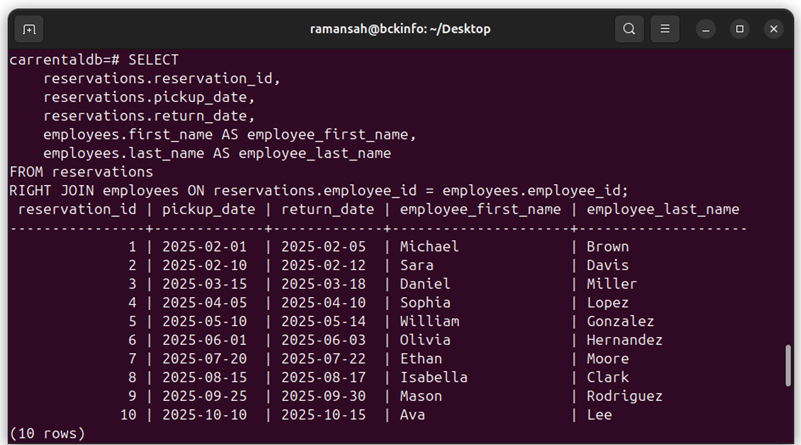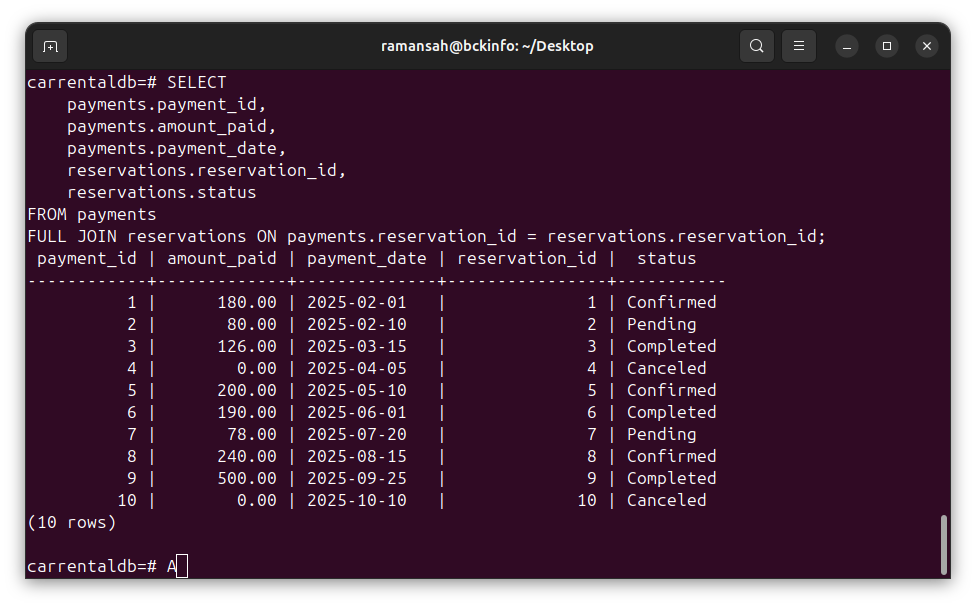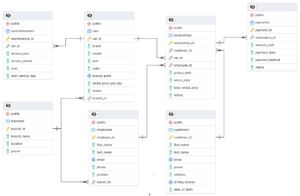Understanding Joins in PostgreSQL: INNER, LEFT, RIGHT, FULL
This section will be using the Sample Database ‘carrentaldb’ article as references for tables to be used. Joins in PostgreSQL are used to combine rows from two or more tables based on a related column. They help retrieve meaningful data from relational databases by linking tables together.
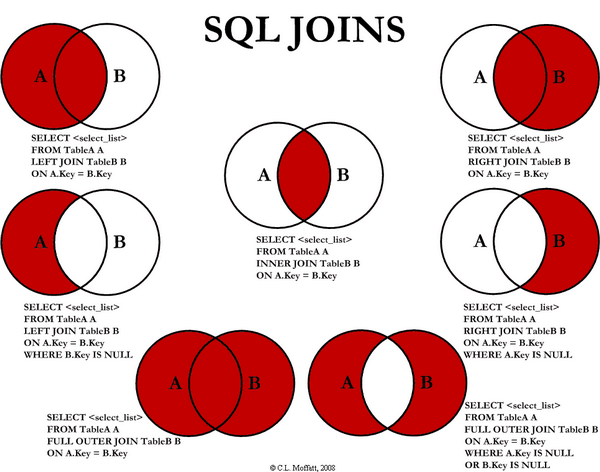
1. INNER JOIN : Fetch Matching Records in Both Tables
An INNER JOIN returns only the rows where there is a match in both tables. If there is no match, the row is excluded from the result.
Example : Retrieve a list of customers along with their reservation details.
SELECT
customers.first_name,
customers.last_name,
reservations.reservation_id,
reservations.pickup_date,
reservations.return_date,
reservations.total_rental_price
FROM customers
INNER JOIN reservations ON customers.customer_id = reservations.customer_id;
Output will be as shown below :
first_name | last_name | reservation_id | pickup_date | return_date | total_rental_price
------------+-----------+----------------+-------------+-------------+--------------------
John | Doe | 1 | 2025-02-01 | 2025-02-05 | 180.00
Jane | Smith | 2 | 2025-02-10 | 2025-02-12 | 80.00
Alice | Johnson | 3 | 2025-03-15 | 2025-03-18 | 126.00
Robert | Brown | 4 | 2025-04-05 | 2025-04-10 | 190.00
Emily | Davis | 5 | 2025-05-10 | 2025-05-14 | 200.00
Michael | Wilson | 6 | 2025-06-01 | 2025-06-03 | 190.00
Jessica | Taylor | 7 | 2025-07-20 | 2025-07-22 | 78.00
David | Anderson | 8 | 2025-08-15 | 2025-08-17 | 240.00
Sarah | Martinez | 9 | 2025-09-25 | 2025-09-30 | 500.00
James | Harris | 10 | 2025-10-10 | 2025-10-15 | 175.00
(10 rows)
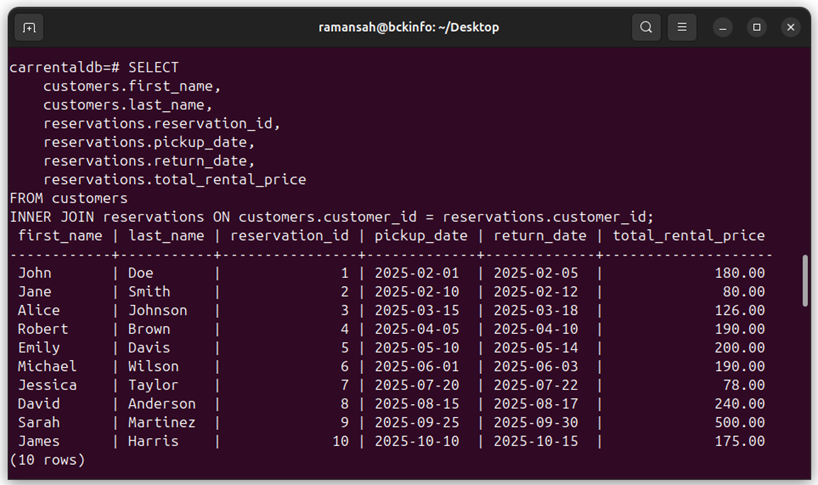
2. LEFT JOIN : Fetch All Records from the Left Table, and Matches from the Right Table
A LEFT JOIN returns all rows from the left table and only matching rows from the right table. If there is no match, NULL values appear for columns from the right table. Retrieve all cars and their associated reservations, if any.
Example : Get All Cars with Their Reservations (Including Cars Not Reserved)
SELECT
cars.car_id,
cars.brand,
cars.model,
reservations.reservation_id,
reservations.pickup_date,
reservations.return_date
FROM cars
LEFT JOIN reservations ON cars.car_id = reservations.car_id;Output will be as shown below :
car_id | brand | model | reservation_id | pickup_date | return_date
--------+-----------+---------+----------------+-------------+-------------
2 | Honda | Civic | 1 | 2025-02-01 | 2025-02-05
1 | Toyota | Corolla | 2 | 2025-02-10 | 2025-02-12
5 | Nissan | Altima | 3 | 2025-03-15 | 2025-03-18
3 | Ford | Focus | 4 | 2025-04-05 | 2025-04-10
4 | Chevrolet | Malibu | 5 | 2025-05-10 | 2025-05-14
7 | Mercedes | C-Class | 6 | 2025-06-01 | 2025-06-03
8 | Hyundai | Sonata | 7 | 2025-07-20 | 2025-07-22
9 | Tesla | Model 3 | 8 | 2025-08-15 | 2025-08-17
6 | BMW | X5 | 9 | 2025-09-25 | 2025-09-30
10 | Kia | Optima | 10 | 2025-10-10 | 2025-10-15
(10 rows)
3. RIGHT JOIN : Fetch All Records from the Right Table, and Matches from the Left Table
A RIGHT JOIN returns all rows from the right table and only matching rows from the left table. If there is no match, NULL values appear for columns from the left table.
Example : Get All Reservations with Employee Details
SELECT
reservations.reservation_id,
reservations.pickup_date,
reservations.return_date,
employees.first_name AS employee_first_name,
employees.last_name AS employee_last_name
FROM reservations
RIGHT JOIN employees ON reservations.employee_id = employees.employee_id;Output will be as shown below :
reservation_id | pickup_date | return_date | employee_first_name | employee_last_name
----------------+-------------+-------------+---------------------+--------------------
1 | 2025-02-01 | 2025-02-05 | Michael | Brown
2 | 2025-02-10 | 2025-02-12 | Sara | Davis
3 | 2025-03-15 | 2025-03-18 | Daniel | Miller
4 | 2025-04-05 | 2025-04-10 | Sophia | Lopez
5 | 2025-05-10 | 2025-05-14 | William | Gonzalez
6 | 2025-06-01 | 2025-06-03 | Olivia | Hernandez
7 | 2025-07-20 | 2025-07-22 | Ethan | Moore
8 | 2025-08-15 | 2025-08-17 | Isabella | Clark
9 | 2025-09-25 | 2025-09-30 | Mason | Rodriguez
10 | 2025-10-10 | 2025-10-15 | Ava | Lee
(10 rows)
4. FULL JOIN : Fetch All Records from Both Tables
A FULL JOIN returns all rows from both tables. If there is a match, the rows are combined. If there is no match, NULL values are used.
Example : Retrieve all payments and their associated reservations, including those with no payments.
SELECT
payments.payment_id,
payments.amount_paid,
payments.payment_date,
reservations.reservation_id,
reservations.status
FROM payments
FULL JOIN reservations ON payments.reservation_id = reservations.reservation_id;Output will be as shown below :
payment_id | amount_paid | payment_date | reservation_id | status
------------+-------------+--------------+----------------+-----------
1 | 180.00 | 2025-02-01 | 1 | Confirmed
2 | 80.00 | 2025-02-10 | 2 | Pending
3 | 126.00 | 2025-03-15 | 3 | Completed
4 | 0.00 | 2025-04-05 | 4 | Canceled
5 | 200.00 | 2025-05-10 | 5 | Confirmed
6 | 190.00 | 2025-06-01 | 6 | Completed
7 | 78.00 | 2025-07-20 | 7 | Pending
8 | 240.00 | 2025-08-15 | 8 | Confirmed
9 | 500.00 | 2025-09-25 | 9 | Completed
10 | 0.00 | 2025-10-10 | 10 | Canceled
(10 rows)
Summary of PostgreSQL Joins
| Join Type | Left Table Rows? | Right Table Rows? | Matched Rows? | Unmatched Rows? |
|---|---|---|---|---|
| INNER JOIN | ✅ Only matched | ✅ Only matched | ✅ Yes | ❌ No |
| LEFT JOIN | ✅ All | ✅ Only matched | ✅ Yes | ✅ Left table only |
| RIGHT JOIN | ✅ Only matched | ✅ All | ✅ Yes | ✅ Right table only |
| FULL JOIN | ✅ All | ✅ All | ✅ Yes | ✅ Both tables |

